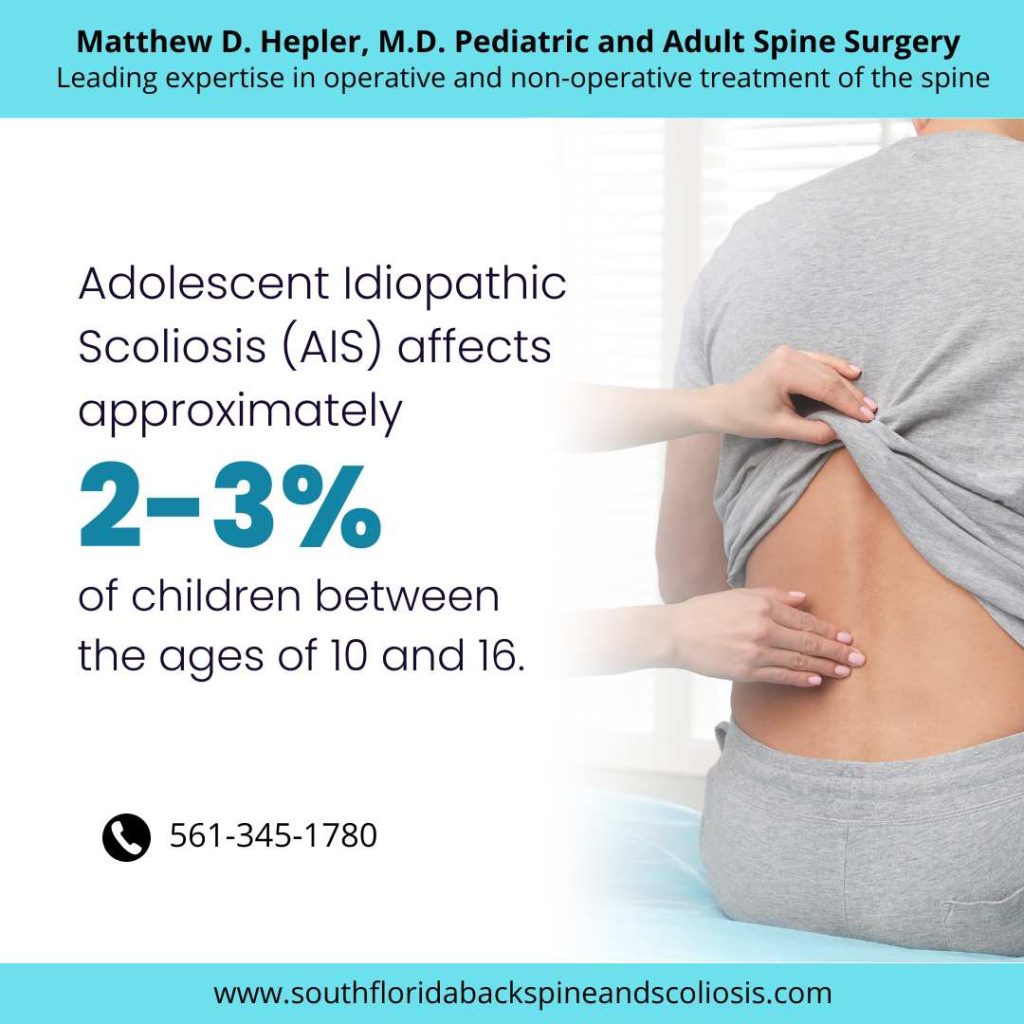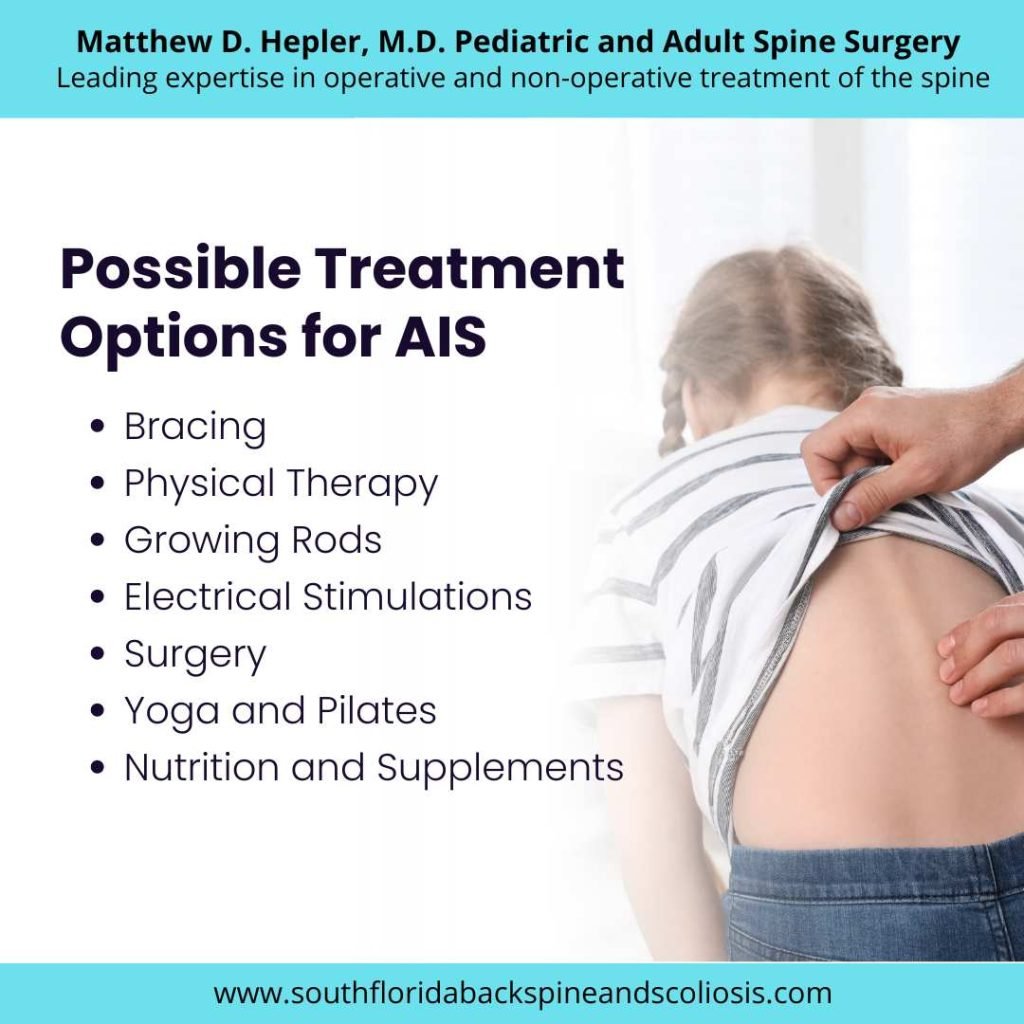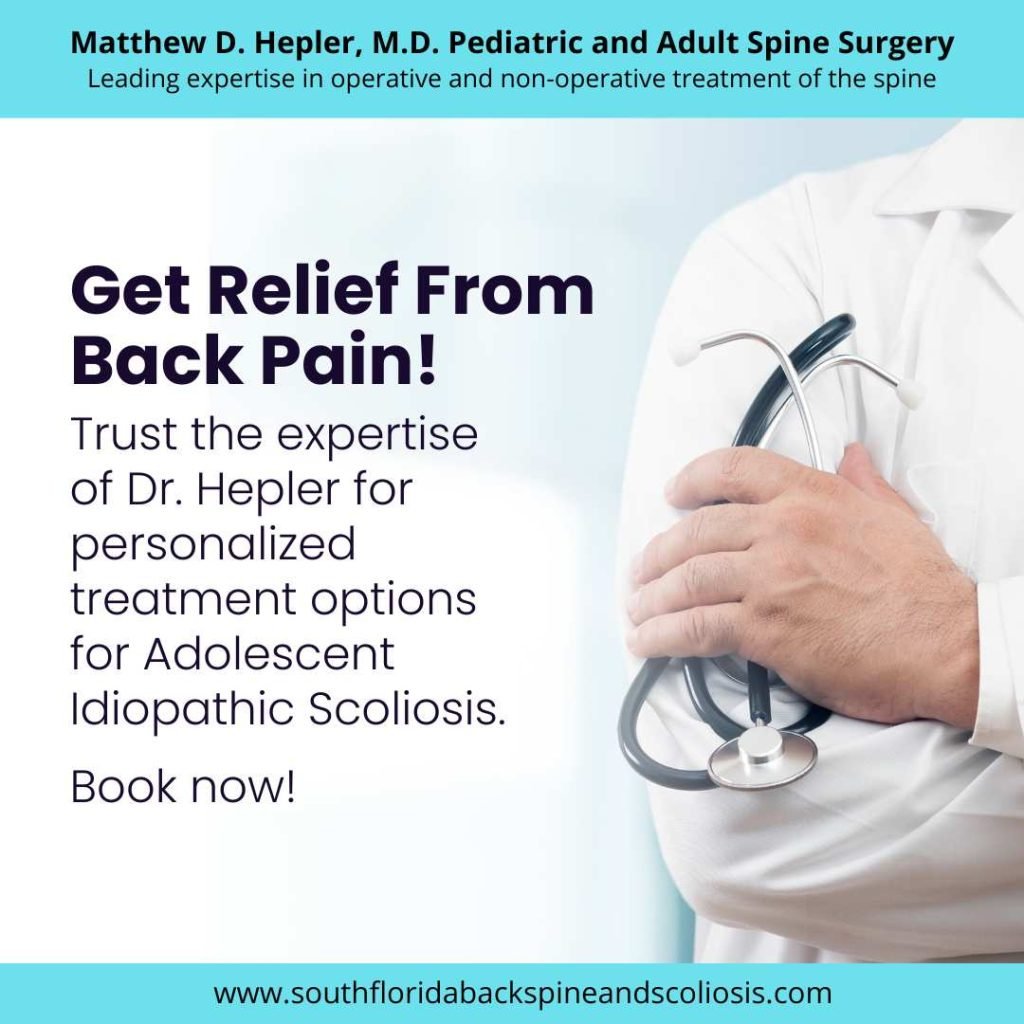Adolescent Idiopathic Scoliosis (AIS)
Adolescent Idiopathic Scoliosis (AIS) affects 2-3% of children ages 10-16. Most cases are mild and do not significantly impact activity level or quality of life. A small percentage of curves will progress, particularly during growth, and may require treatment with a brace. Curves that progress beyond 40-50 degrees are usually treated surgically.
Let’s dive into the details of AIS, covering everything from its symptoms and risk factors to the latest treatment options available. Whether you are looking for information to help your child or simply curious about this condition, read on to discover everything you need to know about AIS.

What is Adolescent Idiopathic Scoliosis?
Scoliosis is a medical term for a sideways curvature of the spine. When this curvature occurs during the adolescent years, it is called Adolescent Idiopathic Scoliosis. Idiopathic means that the cause of the scoliosis is unknown. It is the most common type of scoliosis, accounting for about 80% of all cases.
AIS usually starts during the prepubescent growth spurt (ages 10-14) and progresses during the teenage years. It affects both boys and girls, but girls are more likely to have a severe curvature that requires treatment. AIS can develop in otherwise healthy children with no family history of scoliosis.
Symptoms of AIS
In most cases, AIS does not cause any pain or discomfort. However, some of the common signs and symptoms of AIS include:
- Uneven shoulders or hips
- One shoulder blade sticking out more than the other
- One side of the ribs appears more prominent than the other side
- Leaning to one side
- Clothes not fitting properly
- Abnormal spinal curvature when bending forward
Common Causes of AIS
As mentioned before, the exact cause of AIS has yet to be discovered. However, several factors can contribute to its development.
- Genetics
Researchers have found that AIS tends to run in families. If someone in your family has it, you also have a higher chance of getting it. This is because specific genes may make you more prone to developing a curved spine.
- Growth Spurts
During a growth spurt, your body grows rapidly, and sometimes, this can cause your spine to grow in a curved way. This is because different body parts may grow at different rates, causing your spine to twist and curve.
- Muscle Imbalances
Our muscles are responsible for keeping our spine straight and upright. If there are any imbalances in our muscles or if one side is stronger than the other, our spine can curve.
- Posture
Poor posture habits, such as slouching or hunching over, can put extra pressure on your spine and cause it to curve. Spending a lot of time sitting or using electronic devices without taking breaks to stretch and move around can also lead to bad posture and increase your risk of developing AIS.
- Hormonal Changes
During puberty, your body undergoes many hormonal changes. Some researchers believe these changes play a role in the development of AIS. However, more studies are needed to understand this connection entirely.
How Does AIS Affect Your Body?
To understand how AIS affects your body, let’s first understand the anatomy of your spine. Your spine comprises 33 small bones called vertebrae, which are stacked on top of each other. These vertebrae create the natural curves of your spine, which helps you balance and move. However, when you have AIS, the vertebrae twist and rotate, causing an abnormal sideways curve. This can affect your spine’s natural balance, leading to pain and discomfort. It can also affect your posture and the way you walk.
How is AIS Diagnosed?
As noted earlier, scoliosis usually does not develop symptoms until the curve has progressed to the point of observable structural changes. As a result, patients may be diagnosed too late for nonoperative treatment with a brace.
Many states and countries mandate school screening to identify potential curves for further medical evaluation. This involves the child bending forward (Adams forward bending test) while a trained clinician looks for evidence of spinal asymmetry. Children with significant asymmetry are referred to a spine specialist for further evaluation. Clinical diagnosis is based on scoliosis X-rays with a measurable curvature greater than 10 degrees. Most structural curves involve the thoracic spine, with compensatory curves in the upper and lower lumbar spine.
Treatment Options for AIS

If you or your child has recently been diagnosed with AIS, you may have questions about the treatment options available. Here are the latest treatment options for AIS that can help straighten the spine and improve overall health and quality of life.
- Bracing
One of the most common treatments for AIS is wearing a back brace. This special device is designed to keep the spine in a straighter position and prevent the curve from worsening. A back brace is typically worn for 16-23 hours daily and can be taken off for activities like swimming or sports. The type of brace and the duration of wear will depend on the severity of the curve and the child’s age.
- Physical Therapy
Physical therapy is often recommended as part of the treatment plan for AIS. A physical therapist is a healthcare professional who specializes in helping people improve their movement and strength. They will work with the child to perform specific exercises that can help improve their posture and strengthen the muscles in their back. These exercises can also help prevent the curve from getting worse.
- Growing Rods
For younger children who are still growing, “growing rods” may be recommended. This involves placing metal rods in the spine that can be lengthened as the child grows. These rods can help control the curve until the child is old enough for a more permanent surgery.
- Electrical Stimulation
Another treatment option for AIS is electrical stimulation. This involves sending small electrical currents through the muscles in the back and spine. These currents help relax the muscles and can help reduce pain caused by the curvature of the spine.
- Surgery
In severe cases of AIS, surgery may be recommended. This is usually only considered when the curve is increasing rapidly or causing other health issues, such as difficulty breathing. During surgery, a surgeon will straighten the curve in the spine by placing metal rods, screws, or hooks in the affected area. The rods are left in the spine permanently to keep it in a straighter position.
Dr. Hepler is a leading spine surgeon based in Florida, renowned for his exceptional skill and expertise in back surgery. He is wholly committed to tailoring individualized and impactful treatment plans to address your child’s specific spinal needs.
- Yoga and Pilates
Yoga and Pilates are forms of exercise that focus on improving flexibility, strength, and posture. These exercises can benefit individuals with AIS, as they can help strengthen the muscles in the back and improve overall spinal health.
- Nutrition and Supplements
Maintaining a healthy diet and taking certain supplements can also help treat AIS. Calcium, vitamin D, and magnesium are important for strong bones, and supplementing with these nutrients can help improve spinal health. It’s always important to consult a doctor before starting any new supplement regimen.
Transform Your Child’s Spine Health with Dr. Hepler
Looking for a way to improve your adolescent’s health and well-being? Look no further than Dr. Hepler MD, one of the best spine surgeons in South Florida. With specialized expertise in back surgery, Dr. Hepler is dedicated to providing personalized and effective treatment options for your child’s spinal condition.
Experience our exceptional services by visiting one of our conveniently located clinics in your area:
Schedule a consultation with Dr. Hepler today and give your child the gift of a strong, healthy spine. Your child deserves the best – and Dr. Hepler is here to provide it. Don’t wait any longer, take action now and see the difference that Dr. Hepler can make in your child’s life.
Trust us, their future self will thank you for making the choice to see one of the best spine surgeons in South Florida. Contact us now!

***
The material on this site is for informational purposes only and DOES NOT CONSTITUTE THE PROVIDING OF MEDICAL ADVICE, and is not intended to be a substitute for independent professional medical judgment, advice, diagnosis, or treatment. Always seek the advice of your physician or other qualified healthcare provider with any questions or concerns you may have regarding your health.
